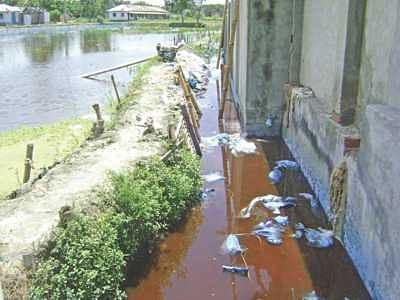Toxic waste of dyeing plant pollutes croplands, poses health hazard

Untreated chemical waste from this dyeing factory at Lashkarpur in Pabna town wreaks havoc to the environment of the residential area as locals' appeal for shifting the large factory outside the populous neighbourhood has fallen into deaf ears.Photo: STAR
Untreated chemical waste from a dyeing factory at Loshkarpur, a densely populated area in Pabna municipality, is not only causing serious environmental degradation but also posing health hazards.
Despite repeated appeals by the residents to relocate the plant outside the residential area, 'Toha Dyeing Factory', one of the largest in the district, has been operating here for the last 18 years.
A huge volume of untreated liquid toxic waste is poured everyday outside the factory, spreading an unpleasant smell in the air. The chemical waste slowly drains its way to the nearby Ichhamati river, polluting its water.
“According to the environmental law, a dyeing factory must set up effluent treatment plant inside the factory. After treatment, the liquid waste can be drained out from the factory,” Md. Saifullah Talukdaer, deputy director of the Department of Environment (DoE) told this correspondent.
“Dumping untreated chemical waste into river is illegal,” he said.
Continuous flow of chemical waste causes immense sufferings to the villagers. Students and teachers of Pabna Homeopathic College (PHC) adjacent to the factory also complain of unbearable stench that disrupts academic activities.
“The toxic water discharged from inside the factory contaminates our ponds and threatens our fish farming and crops, especially when it rains,” said Md Golam Mostafa, a resident of the village.
“Teachers and students of PHC are exposed to the pollution to a higher degree as the waste accumulates very close to it,” said Mostafa, also a lecturer of the college. He said the college authorities requested the local administration in writing to solve the long standing problem but it fell on deaf ears.
Farmers also submitted numerous complaints to the local administration and the DoE, but to no effect.
The owners of the factory are influential people. Years ago when the factory was built, population at the village was very thin, Md Ashraful Pramanik, councillor of the ward, said. Pramanik claimed that the factory has approval from the Department of Environment (DoE) and that is why the municipality does not take any step to remove it.
“Officials of the municipality visited the factory and examined the papers, including approval of the Department of Environment (DoE).” Councilor Ashraf said, adding that Pabna municipal authorities have already built a concrete drain beside the factory and the construction of another drain to facilitate release of the liquid waste from the factory is underway.
When this correspondent tried to talk to Md Abul Hossain Shuvra, one of the owners, he reacted sharply, brushing aside all allegations.
Md Ataur Rahman Sachchu, another owner, claimed they are just doing a harmless activity by washing and dyeing threads.
“Waste does not remain stagnant anywhere on its way to the river, so there is no scope of pollution.” Sachchu said.
Officials of DoE Rajshahi zonal office at Bogra said the department gave the approval years ago with a few conditions that included setting up of waste treatment plant inside the factory.
“If the factory does not fulfil the conditions, it must be punished for its offence.” Md Saifullah Talukder, deputy director DoE Bogra office, said.

 For all latest news, follow The Daily Star's Google News channel.
For all latest news, follow The Daily Star's Google News channel. 



Comments